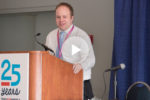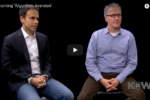
Iris Bohnet, Professor of Public Policy at Harvard Kennedy School, talks with Laura Zarrow about how behavioral design can de-bias how we live, learn and work. Bohnet is the author of the book, ‘What Works: Gender Equality by Design’.…Read More

Iris Bohnet, Professor of Public Policy at Harvard Kennedy School, talks with Laura Zarrow about how behavioral design can de-bias how we live, learn and work. Bohnet is the author of the book, ‘What Works: Gender Equality by Design’.…Read More

Kara Chambers, Chief Learning Officer, and Lee Burbage, Chief People Officer at The Motley Fool, joins hosts Mike Useem and Anne Greenhalgh in preparation for the Wharton People Analytics Conference 2017 to discuss how their 300 employee business has started integrating people analytics for enacting data driven decisions to better their workplace culture on Leadership in Action.…Read More

Sean Waldheim, Vice President of Admissions at Teach for America, joins hosts Mike Useem and Anne Greenhalgh in preparation for the Wharton People Analytics Conference 2017 to discuss using research to define characteristics of successful teachers in the TFA program and how TFA can have the most impact in low income schools on Leadership in Action.…Read More

Matthew Salganik, Professor of Sociology at Princeton University, joins host Cade Massey to discuss social sciences and the world of data and his book “Bit by Bit: Social Research in the Digital Age” live from the Wharton People Analytics Conference 2017.…Read More

Trisha Williams, Founder and Chief Creative Officer at Pigeon Hole Productions, joins host Cade Massey to discuss the blending of people analytics and game design live from the Wharton People Analytics Conference 2017.…Read More

Joelle Emerson, Founder and CEO of Paradigm, joins host Cade Massey to discuss how people analytics can help businesses improve their diversity live from the Wharton People Analytics Conference 2017.…Read More

Keith McNulty, Head of People Analytics and Measurement at McKinsey & Company, joins host Cade Massey to discuss Big Data and how it plays into people analytics live from the Wharton People Analytics Conference 2017.…Read More

Knowledge@Wharton Mathematical models have been used to augment or replace human decision-making since the invention of the calculator, bolstered by the notion that a machine won’t make mistakes. Yet many people are averse to using algorithms, preferring instead to rely on their instincts when it comes to a variety of…Read More

Generosity has a dark side: If we don’t put boundaries around it, we run the risk of burning ourselves out-and hurting the people we’re trying to help . Though we want a workforce of givers, not takers, the givers need to rein themselves in for everyone’s sake. Find out how to do that by joining HBR for this weeklong series with Wharton’s Adam Grant and Reb Rebele. It includes a new feature article about how to help others more effectively, a video explaining the research, audio “postcards” from leaders who get how to give, a self-assessment, and more.…Read More

Collaboration is taking over the workplace. As business becomes increasingly global and cross-functional, silos are breaking down, connectivity is increasing, and teamwork is seen as a key to organizational success.…Read More